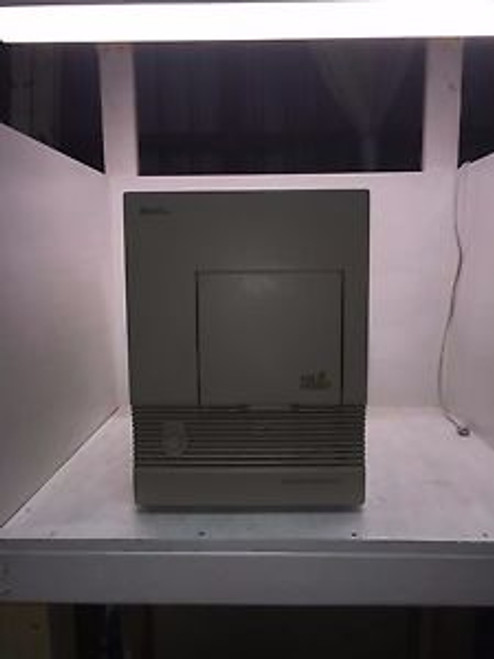Applied Biosystems 8200 Cellular Detection System The Applied Biosystems 8200 Cellular Detection System is a fluorescence macro-confocal, biological binding event analyzer.
The System enables high throughput screening via a broad range of cell-based and bead-based assays. The System is based on the proprietary FMAT (Fluorometric Microvolume Assay Technology) System providing users with a homogenous, mix-and-read assay format.
The 8200 software is user-friendly and offers a wide variety of tools for data acquisition and analysis. The integrated robotic plate handler allows walk-away automated high throughput mode operation. Mix-and-Read Assay Format: The mix-and-read capabilities of the 8200 Cellular Detection System eliminates assay wash and incubation steps; thereby increasing sample throughput and decreasing reagent requirements.
The 8200 System scans a 1mm2 area of a microplate well at a depth of 100 µm. Fluorescence outside this volume is undetected, so that the signal-to-noise ratio is dramatically increased. Fluorescence detected within this volume but not bound to a bead or cell, is eliminated by the System software.
Low Autofluorescence The 8200 System’s red 633 nM HeNe laser greatly diminishes autofluorescence, resulting in low background signal. Excitation at shorter wave lengths may result in unacceptable levels of autofluorescence by the assay matrix, test materials and cells. Walk Away Automation: Included with the system is a Caliper Twister® robotic plate handler with four input stacks that hold a total 60 plates.
Selection of the robotic plate handling option allows unattended operation. Multiplexing Capability Multiplexed assays performed with different bead sizes and dye colors allow the simultaneous detection of multiple binding events. System software uses proprietary algorithms to discriminate bead size. Two photo multiplier tubes (PMTs) allow for capture of two distinct emissions in the red spectrum.
Assay Versatility Cell-based assays may be conducted on live or fixed cells and with both adherent and suspension cell lines. Bead-based assays are also easy to perform on the 8200 System. Existing ELISAs in a traditional assay format are easily converted to the mix-and-read 8200 assay format. Cell-Based Applications: The 8200 Cellular Detection System is a valuable tool for monitoring regulation of surface antigens, receptor-ligand binding, identification of antibodies to cell surface target proteins, and detection of intracellular antigens in live and fixed cells. The 8200 System is a proven, established platform for drug target discovery, therapeutics and basic life science research. Hybridoma Screening: The 8200 Cellular Detection System is a preferred platform for screening hybridoma supernatants due to its sensitivity, mix-and-read assay format and walk-away automation. The standard protocol for screening is simple and uses far less reagent than other screening methods.
The format allows use of adherent and suspension cells expressing surface target proteins and has proven successful in screening whole antibodies as well as antibody fragments (Fab and scFv). Screening for antibodies against soluble antigens may be performed using a bead-based assay. (See “Bead-Based Applications” Table 1). Apoptosis Selective blockade or induction of the apoptosis process is a key target of drug discovery and other research. Because the 8200 Cellular Detection System has multi-plexing capabilities, apoptotic cells can be labeled with fluorescent Annexin V and compared to total cell number determined by nuclear staining. The 8200 System software calculates the percent apoptotic cells as the number of Annexin V labeled cells per number of nuclear labeled cells. Receptor–Ligand Binding: Chemokine or Peptide The 8200 Cellular Detection System is also ideal for studying receptor ligand interaction.
This application has proven successful in compound screening for chemokine receptor-ligand binding and IC50 analyses for drug target validation. Screening is performed with FMAT Blue-labeled ligand. FMAT® Blue is a proprietary dye formulated for optimal intensity and photostability. The 8200 software automatically generates IC50 curve plots and values. This assay can be performed on either adherent cells or cells in suspension. Monitoring Cell Surface Receptors/CD Marker Expression Monitoring of CD marker expression provides valuable insight into immunological processes. This application uses dye-labeled antibodies directed against the CD marker of interest.
Using the multiplexing capability of the 8200 Cellular Detection System, the cell surface expression of ICAM-1has been detected and secreted IL-8 has been quantified simultaneously, in the same plate well. Intracellular Antigen Detection Intracellular nuclear or cytoplasmic antigens may be detected in permeabilized cells using fluorescently labeled antibodies. Bead-Based Applications Bead-based applications on the 8200 Cellular Detection System cover a wide range of assays. The principles for developing a bead-based assay on the 8200 Cellular Detection System are similar to assay development of traditional ELISAs. Beads are coated with specific antibodies or antigens of interest and are used as a binding surface in place of the wells of a microtiter plate. Existing ELISA protocols may be easily converted to the 8200 mix-and-read assay format. In general, conversion from a conventional ELISA to a bead-based 8200 assay format yields comparable dynamic range and sensitivity with the advantages of a mix and read, automatable format and reduced reagent requirements.
Hybridoma Screening Screening of hybridoma supernatants in which antibodies are directed against soluble antigens is easily performed using a bead-based mix and read assay format. Antigen coated beads, hybridoma supernatant and secondary labeled detection antibodies are added simultaneously to wells of microtiter plates. Plates are incubated and then read on the 8200 Cellular Detection System. Quantitation Assays Quantitation assays for soluble factors such as cytokines or antibodies may be performed using bead-based assays. The 8200 analysis software generates a standard curve from a series of assigned standard wells and assigns values to unknowns. Multiplexing by size or color allows multiple parameters to be monitored in the same assay well.






